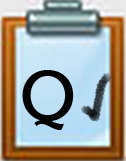Q2 That Didn't Work. Now What? Vocabulary
Key Vocabulary
Application: An application, also known as an "app," is a type of software designed to perform specific tasks or provide certain functionalities. Examples of applications include word processors, web browsers, games, and photo editing tools.
Flowchart: A flowchart is a diagram that shows how you progress step-by-step using connecting lines and a set of conventional symbols.
Frozen: When a computer or application is frozen, it means it becomes unresponsive and stops working properly. You may not be able to click or interact with anything on the screen, and the computer might not respond to your commands. It often requires troubleshooting steps to resolve the issue and regain control of the device or application.
Hardware: Hardware refers to the physical components of a computer, such as the keyboard, mouse, monitor, and internal parts like the processor and memory. It's the tangible, touchable part of the computer.
Software: Software refers to the programs, apps, and operating systems that run on a computer. It includes all the instructions and code that tell the computer what to do. Software is intangible and stored on the computer's hardware.
Solve: To solve is to find the answer.
Troubleshoot: Troubleshooting is identifying and fixing problems with software or hardware.
Competencies & Standards
MITECS Michigan Integrated Technology Competencies for Students, and
1. Empowered Learner
a. Articulate and set personal learning goals, developing strategies leveraging technology to achieve them, and reflect on the learning process itself to improve learning outcomes
c. Use technology to seek feedback that informs and improves their practice and to demonstrate their learning in a variety of ways
d. Understand the fundamental concepts of technology operations, demonstrate the ability to choose, use and troubleshoot current technologies, are able to transfer their knowledge to explore emerging technologies
5. Computational Thinker
c. Break problems into component parts, extract key information and develop descriptive models to understand complex systems or facilitate problem solving
6. Creative Communicator
a. Choose the appropriate platforms and tools for meeting the desired objectives of their creation or communication
c. Communicate complex ideas clearly and effectively by creating or using a variety of digital objects such as visualizations, models or simulations
Websites and Documents
21t4s Videos
21t4s Websites
21t4s Documents & Quizzes
- Troubleshooting Flowchart (worksheet)
- Vocabulary Quizlet




